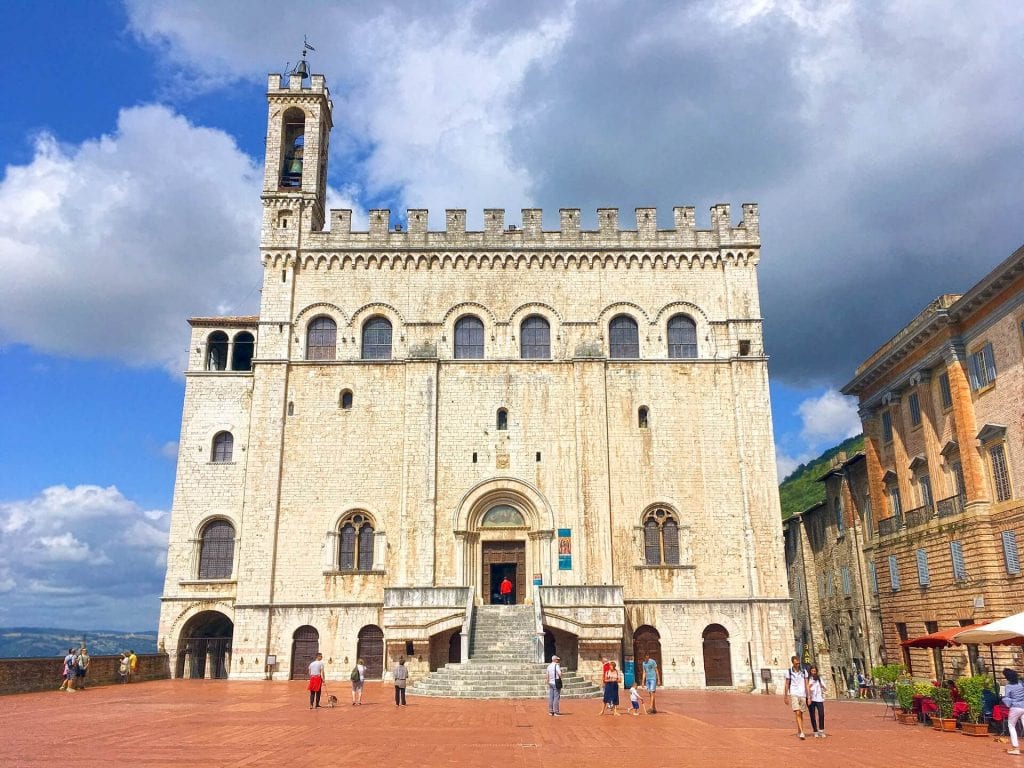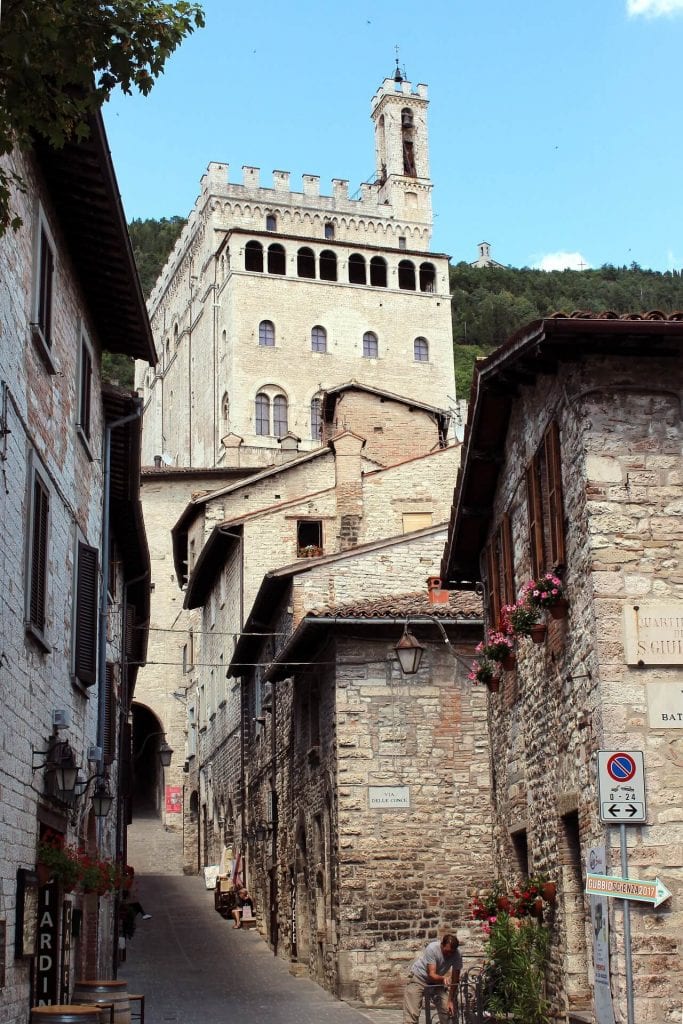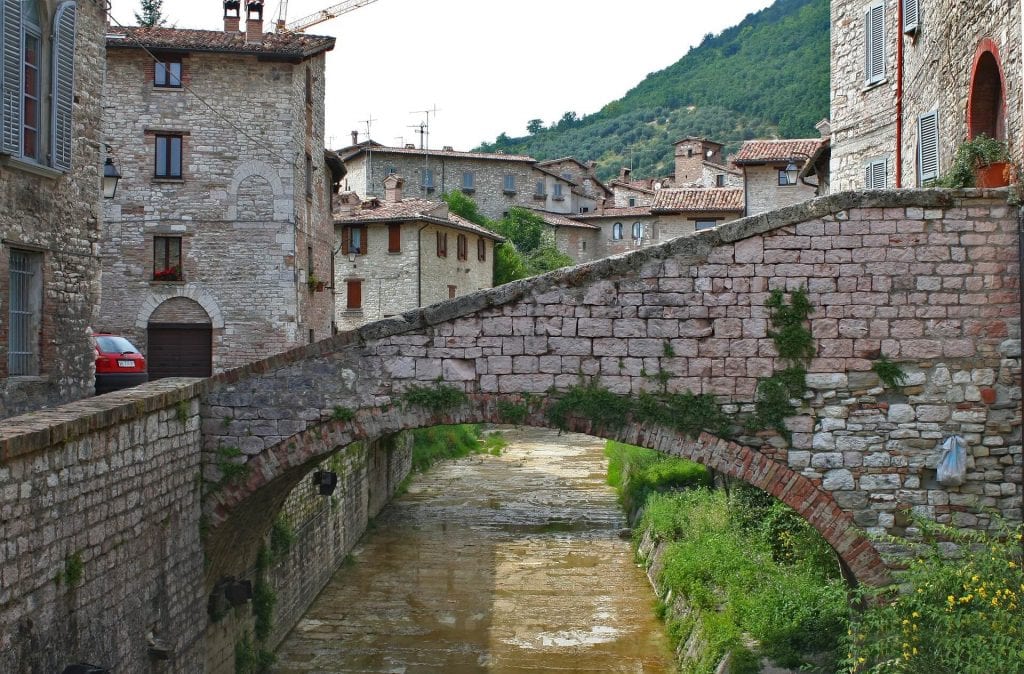Gubbio is a town and comune in the far northeastern part of the Italian province of Umbria. It is located on the lowest slope of Mt. Ingino, a small mountain of the Apennines.
The city’s origins are very ancient. The hills above the town were already occupied in the Bronze Age. As Ikuvium, it was an important town of the Umbri in pre-Roman times, made famous for the discovery there of the Iguvine Tablets in 1444, a set of bronze tablets that together constitute the largest surviving text in the Umbrian language. After the Roman conquest in the 2nd century BC — it kept its name as Iguvium — the city remained important, as attested by its Roman theatre, the second-largest surviving in the world.
Gubbio became very powerful in the beginning of the Middle Ages. The town sent 1000 knights to fight in the First Crusade under the lead of Girolamo Gabrielli, and according to an undocumented local tradition, they were the first to penetrate into the Church of the Holy Sepulchre when the city was seized (1099).
The following centuries were quite turbulent, and Gubbio was engaged in wars against the surrounding towns of Umbria. One of these wars saw the miraculous intervention of its bishop, Ubald, who secured Gubbio an overwhelming victory (1151) and a period of prosperity. In the struggles of Guelphs and Ghibellines, the Gabrielli, such as the condottiero Cante dei Gabrielli da Gubbio (c. 1260 – 1335), were of the Guelph faction, supportive of the papacy; as Podestà of Florence, Cante exiled Dante Alighieri, ensuring his own lasting notoriety.
In 1350 Giovanni Gabrielli, count of Borgovalle, a member of the most prominent noble family of Gubbio, seized communal power and became lord of Gubbio..
A few years later, Gabriello Gabrielli, bishop of Gubbio, proclaimed himself again lord of Gubbio (Signor d’Agobbio). Betrayed by a group of noblemen which included many of his relatives, the bishop was forced to leave the town and seek refuge at his home castle at Cantiano.
With the decline of the political prestige of the Gabrielli family, Gubbio was thereafter incorporated into the territories of the House of Montefeltro. Federico da Montefeltro rebuilt the ancient Palazzo Ducale, incorporating in it a studiolo veneered with intarsia like his studiolo at Urbino. The maiolica industry at Gubbio reached its apogee in the first half of the 16th century, with metallic lustre glazes imitating gold and copper.
Gubbio became part of the Papal States in 1631, when the family della Rovere, to whom the Duchy of Urbino had been granted, was extinguished. In 1860 Gubbio was incorporated into the Kingdom of Italy along with the rest of the Papal States.
The historical centre of Gubbio has a decidedly medieval aspect: the town is austere in appearance because of the dark grey stone, narrow streets, and Gothic architecture.
Many houses in central Gubbio date to the 14th and 15th centuries, and were originally the dwellings of wealthy merchants.
They often have a second door fronting on the street, usually just a few inches from the main entrance. This secondary entrance is narrower, and a foot or so above the actual street level. This type of door is called a porta dei morti (door of the dead) because it was proposed that they were used to remove the bodies of any who might have died inside the house. This is almost certainly false, but there is no agreement as to the purpose of the secondary doors. A more likely theory is that the door was used by the owners to protect themselves when opening to unknown persons, leaving them in a dominating position.

Among most visited buildings and sites in the city are:
- Roman Theater: This ancient open air theater built in the 1st century BC using square blocks of local limestone. Traces of mosaic decoration have been found. Originally, the diameter of the cavea was 70 metres, and could house up to 6,000 spectators.
- Roman Mausoleum: This Mausoleum is sometimes said to be of Gaius Pomponius Graecinus, but on no satisfactory grounds.
- Palazzo dei Consoli: Dating to the first half of the 14th century, this massive palace, is now a museum housing the Iguvine Tablets.
- Palazzo and Torre Gabrielli
- Duomo: This Cathedral was built in the late 12th century. The most striking feature is the rose-window in the façade with, at its sides, the symbols of the Evangelists: the eagle for John the Evangelist, the lion for Mark the Evangelist, the angel for Matthew the Apostle and the ox for Luke the Evangelist. The interior has latine cross plan with a single nave. The most precious art piece is the wooden Christ over the altar, of Umbrian school.
- Palazzo Ducale: The Palace built from 1470 by Luciano Laurana or Francesco di Giorgio Martini for Federico da Montefeltro. Famous is the inner court, reminiscent of the Palazzo Ducale, Urbino.
- San Francesco: This church from the second half of the 13th century is the sole religious edifice in the city having a nave with two aisles. The vaults are supported by octagonal pilasters. The frescoes in the left side date from the 15th century.
- Santa Maria Nuova: This is a typical Cistercian church of the 13th century. In the interior is a 14th-century fresco portraying the so-called Madonna del Belvedere (1413), by Ottaviano Nelli. It also has a work by Guido Palmeruccio. Also from the Cistercians is the Convent of St. Augustine, with some frescoes by Nelli.
- Basilica of Sant’Ubaldo, with a nave and four aisles is a sanctuary outside the city. Noteworthy are the marble altar and the great windows with episodes of the life of Ubald, patron of Gubbio. The finely sculpted portals and the fragmentary frescoes give a hint of the magnificent 15th-century decoration once boasted by the basilica.
- Museo Cante Gabrielli: This museum is housed in the Palazzo del Capitano del Popolo, which once belonged to the Gabrielli family.



